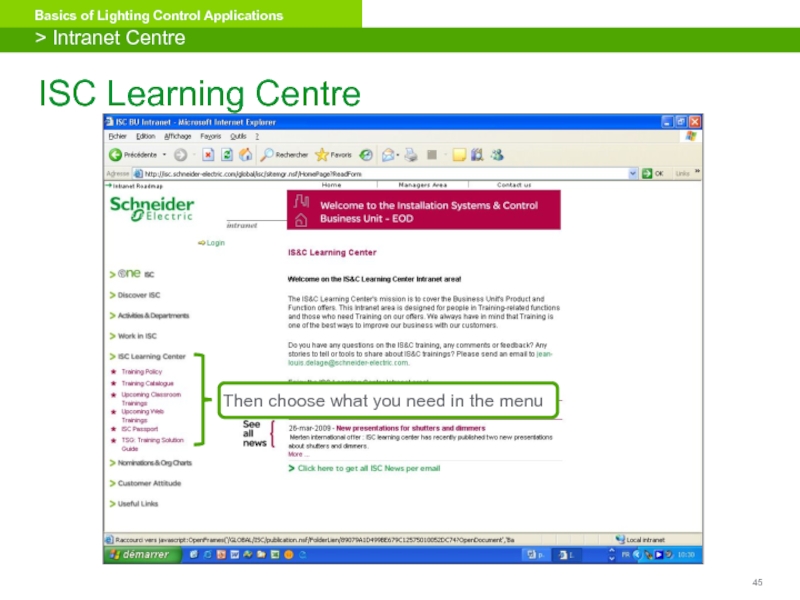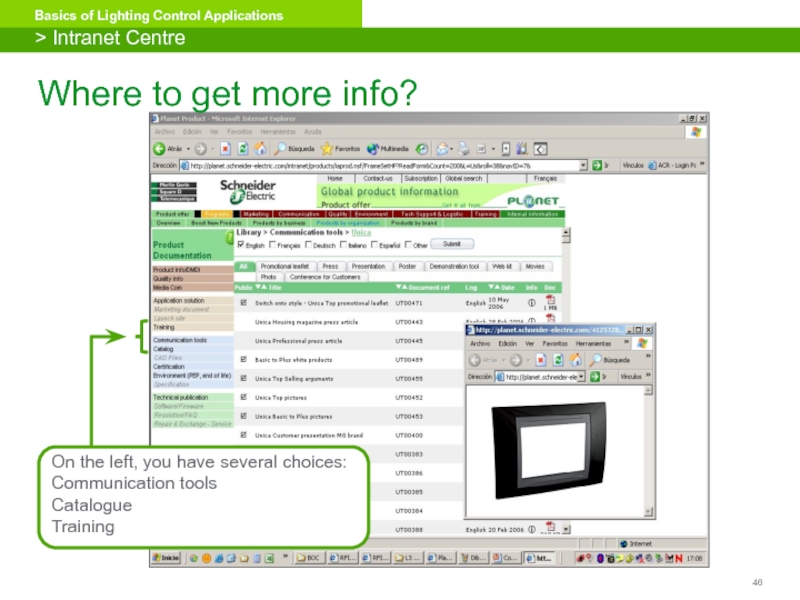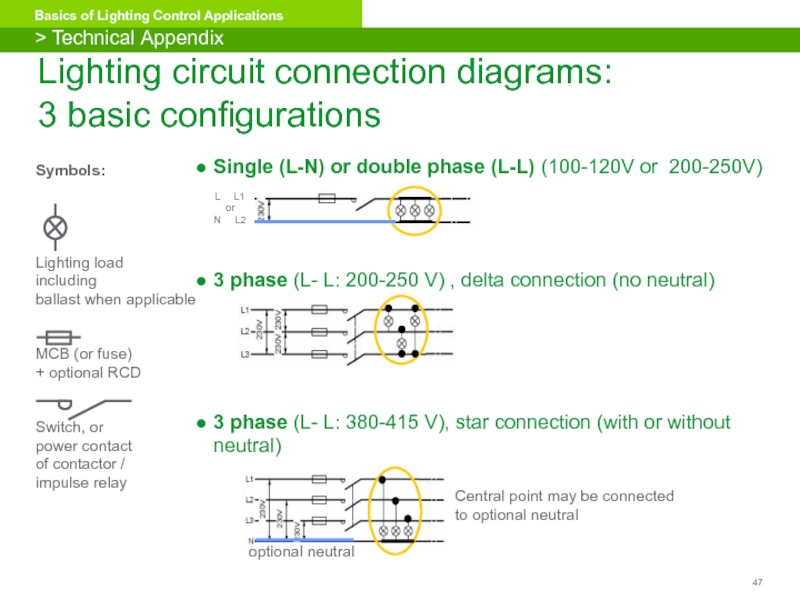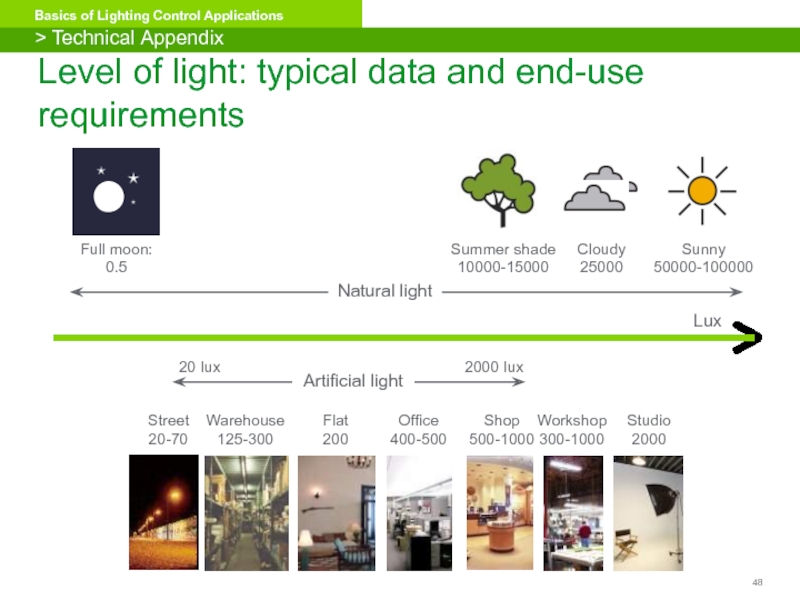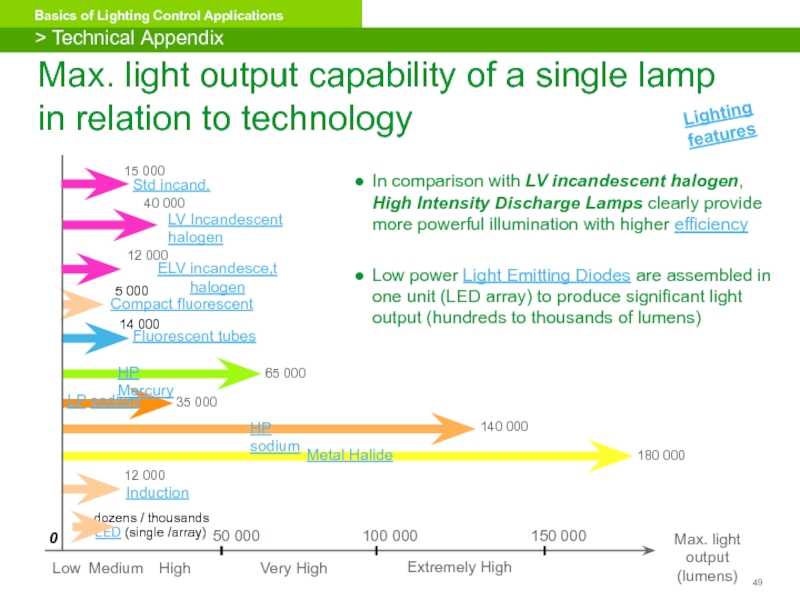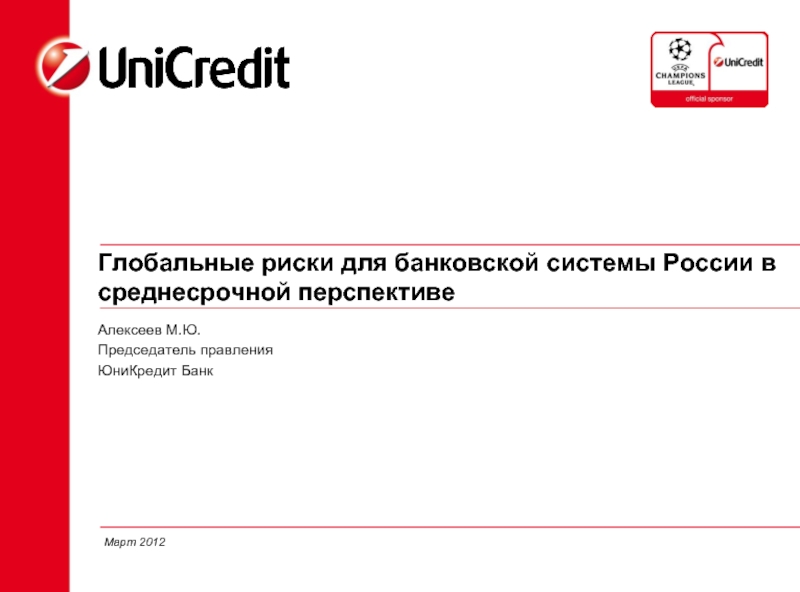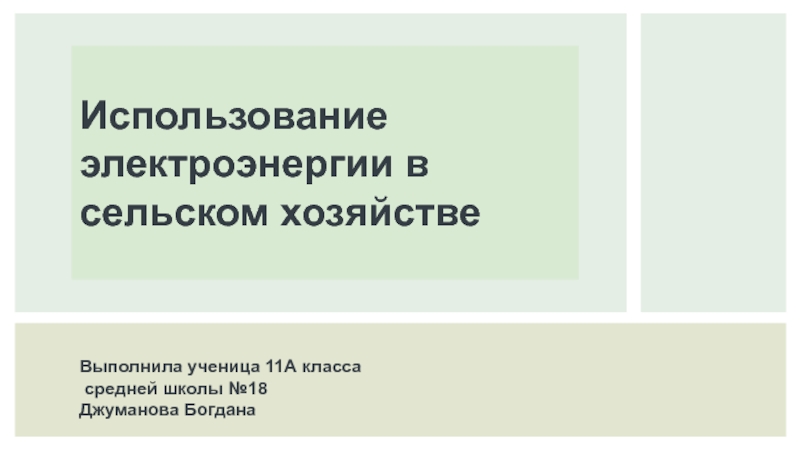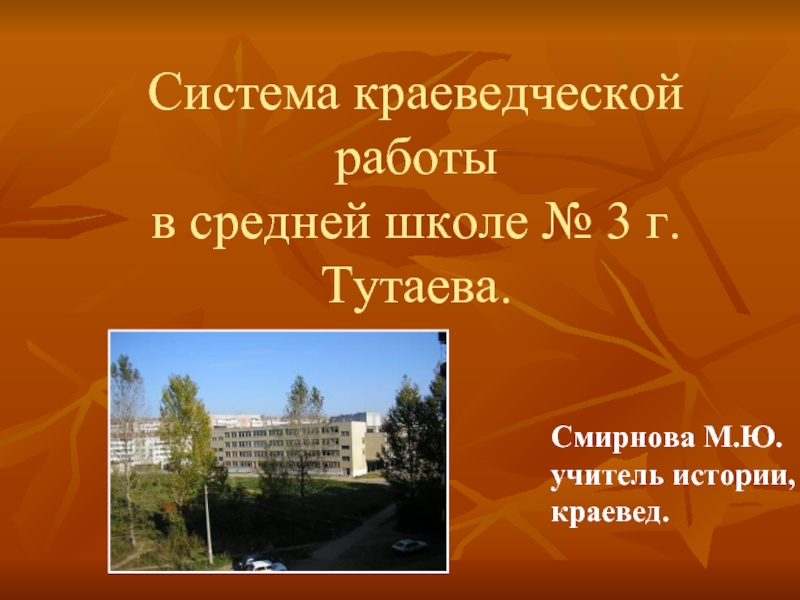- Главная
- Разное
- Дизайн
- Бизнес и предпринимательство
- Аналитика
- Образование
- Развлечения
- Красота и здоровье
- Финансы
- Государство
- Путешествия
- Спорт
- Недвижимость
- Армия
- Графика
- Культурология
- Еда и кулинария
- Лингвистика
- Английский язык
- Астрономия
- Алгебра
- Биология
- География
- Детские презентации
- Информатика
- История
- Литература
- Маркетинг
- Математика
- Медицина
- Менеджмент
- Музыка
- МХК
- Немецкий язык
- ОБЖ
- Обществознание
- Окружающий мир
- Педагогика
- Русский язык
- Технология
- Физика
- Философия
- Химия
- Шаблоны, картинки для презентаций
- Экология
- Экономика
- Юриспруденция
Basics of Lighting презентация
Содержание
- 1. Basics of Lighting
- 2. Basics of lighting - Contents Introduction Selection
- 3. Why this module? With the world focusing
- 4. Lighting & energy consumption Lighting alone is
- 5. Buildings Lighting = 25 to 50% (average
- 6. Industry & Housing Lighting = 10 to
- 7. On the market today Two main technologies
- 8. Technologies on the market Incandescent bulbs "GLS"*:
- 9. Applications / Lights: Buildings Fluorescent tubes
- 10. Lighting - Selection parameters Lighting needs in
- 11. Fluorescent tubes The most frequently used! Accept
- 12. Control circuits for fluorescent tubes & high
- 13. Fluorescent tubes - Wiring diagrams Single tube,
- 14. Fluorescent tubes - Lifetime Fluorescent tubes lifetime
- 15. Conventional ON/OFF 10 A or 16 A
- 16. Conventional Dimming Stand-Alone Electronic Potentiometer
- 17. Power line Bus Push-Buttons
- 18. Control by lighting bus: DALI Bus –
- 19. DALI system structure > Building lighting -
- 20. Gateway for fluorescent tubes on DALI bus
- 21. DALI bus Dimmable fluorescent tubes L N
- 22. Connection to our LON DALI gateway >
- 23. Benefits compared to 1-10V control systems Individual
- 24. Differences between DALI and BA buses (KNX,
- 25. DSI for Digital Serial Protocol 1991
- 26. Introduction to home lighting Energy efficient lighting
- 27. Incandescent lamp (GLS) (E-class) 1879 (Thomas Edison)
- 28. Conventional halogen lamps (D or E-class) 1980s
- 29. 12Vdc lamps (+ transformer) Lamp power:
- 30. Halogen lamps with xenon gas filling (C-class)
- 31. Halogen lamps with infrared coating (B-class) Recent
- 32. Compact fluorescent lamps (CFLs) (A-class) Fluorescent lamp
- 33. Light-emitting diodes (LEDs) Very long lifetime Quickly
- 34. Efficiency of lamp technologies compared with incandescent
- 35. Wiring Devices for essential lighting
- 36. High Intensity Discharge lamps (HID) Produce light
- 37. Main use: Public lighting, industry, shelters, docks,
- 38. Main use: Outdoors only, road & security
- 39. Main use: Streets, monuments, tunnels, airports, docks,
- 40. Main use: streets, car parks, shopping malls,
- 41. Main use: areas with difficult access or
- 42. Schneider products to control this type of
- 43. In the same set of basics Module
- 44. ISC Learning Centre From Swebi -
- 45. ISC Learning Centre > Intranet Centre
- 46. On the left, you have
- 47. Lighting circuit connection diagrams: 3 basic
- 48. Level of light: typical data and end-use
- 49. Max. light output capability of a single
- 50. Thanks! ISC Learning Centre Make the most of your energy
Слайд 2Basics of lighting - Contents
Introduction
Selection parameters
Overview of building lighting
Overview of
Overview of other types of lighting
Introduction to lighting bus
Слайд 3Why this module?
With the world focusing on how to reduce the
With professionals wanting more efficiency and safety at work
With consumers seeking to improve comfort and security
The types of lighting have become more and more varied
The choice of lighting is becoming more and more important
The objective of this module is to give you basic information on the different lights found on the market and help you understand their connection with our lighting control offer.
> Introduction
This module is the first of a set of basic modules
on Lighting Control (see list at the end of the module)
Слайд 4Lighting & energy consumption
Lighting alone is responsible for 19% of the
Lighting accounts for 10 to 33% (USA) of each country's electricity consumption
A huge concern especially for public lighting (30% more than 20 years old)
> Introduction
Слайд 5Buildings
Lighting = 25 to 50% (average 40%) of electricity bill
Offices, hotels,
> Lighting & Energy Consumption
Schools, gymnasiums, medical care
Слайд 6Industry & Housing
Lighting = 10 to 15% of the electricity bill
Power
Apartment buildings, homes
> Lighting & Energy Consumption
Слайд 7On the market today
Two main technologies
Incandescent lamps
Gas discharge lamps
Several types of
Professional use
Private use
Types of control
Conventional (wiring)
Field-bus
Central systems
> Overview of lights on the market
Слайд 8Technologies on the market
Incandescent bulbs "GLS"*:
Most common bulbs
LV & ELV* halogen
Gas discharge lamps:
Fluorescent lights:
Low pressure mercury fluorescent tubes
Compact Fluorescent Lamps "CFL"
High Intensity Discharge lights "HID"
High Pressure Mercury "MBF"
Low Pressure Sodium "LPS, SLP, SOX"
High Pressure Sodium "HPS, SHP, SON"
Metal Halide "MH, HQI, MIB"
Others: Light Emitting Diodes "LED", induction
*GLS= Global Light Source
*ELV: Extra Low Voltage (12Vdc)
> Overview of lights on the market
Слайд 9Applications / Lights:
Buildings
Fluorescent tubes
Metal halide "MH, HQI, MIB"
Lights for homes,
Incandescent bulbs + LV & ELV halogen
Fluorescent tubes + Compact Fluorescent Lamps "CFL"
Others: Light Emitting Diodes "LED", induction
Others (such as public lighting, outdoor lighting)
High Intensity Discharge lights "HID"
High Pressure Mercury "MBF"
Low Pressure Sodium "LPS, SLP, SOX"
High Pressure Sodium "HPS, SHP, SON"
Metal Halide "MH, HQI, MIB"
> Overview of lights on the market
Слайд 10Lighting - Selection parameters
Lighting needs in relation to end-use
Required brightness
Environment (temperature, humidity, etc.)
Aesthetics
Colour rendering (capacity of lighting to render the colours of the illuminated object)
Lifetime (with respect to daily and yearly operating time)
Frequency of switching (daily on / off operations)
Lamp starting and warm-up times (how long it takes to reach the full light output)
Dimming capability (some types of lights are not dimmable)
Size for compatibility with existing light fixtures
Diffused or spot lighting, mounting height (low bay / high bay)
Safety, extra low voltage, CFL not too close to people's heads
Easy maintenance
Overall cost (investment cost + operating cost)
> Overview of lights on the market
Слайд 11Fluorescent tubes
The most frequently used!
Accept frequent On/Off switching
Lamp power: 4 to
Lifetime of fluorescent tubes depends on daily On / Off frequency and type of ballast
Several types of fixtures according to use: 3m to 12m height (high efficiency), hanging, surface or flush mounted, single, twin or multiple tube fixture, IP 65 version...
> Overview of building lighting
Слайд 12Control circuits for fluorescent tubes & high intensity discharge lamps
Electronic ballast
Magnetic
> Overview of building lighting
Слайд 13Fluorescent tubes - Wiring diagrams
Single tube, magnetic ballast with no compensation
☹ p.f. < 0.5, flicker, noise, low lifetime 8000h, inrush current 13 In / 5-10ms
☺ simple, cheap
Single tube, magnetic ballast with parallel compensation
☹ flicker, noise, very high inrush current 20-60 In / 1ms
☺ p.f. > 0.85, improved lifetime
Single tube, magnetic ballast with serial compensation (cap. load)
☹ flicker, noise, high inrush current 13 In / 5-10ms
☺ p.f. > 0.85, improved lifetime
Twin compensated tubes with magnetic ballast
☹ High inrush current 20 In / 1ms
☺ Limited flicker, low noise, p.f. > 0.85, improved lifetime
One or more tubes with electronic ballast
☹ Very high inrush current 30-100 In / 0.5ms, HF earth leakage detected by RCD
☺ No flicker, silent, high efficiency (+25%), longer lifetime (+ 50%), p.f. > 0.9
Control circuit
> Overview of building lighting
Слайд 14Fluorescent tubes - Lifetime
Fluorescent tubes lifetime
Daily On / Off frequency
Daily On / Off
switching
frequency (h)
Lifetime
(x 1000 h)
Type of control ballast:
electronic with progressive warm-up process
compensated magnetic
non compensated magnetic
1
2
3
> Overview of building lighting
Слайд 15Conventional ON/OFF
10 A or 16 A switch
Can be connected to
Single tube,
Single tube, magnetic ballast with parallel compensation
Single tube, magnetic ballast with serial compensation
Twin compensated tubes with magnetic ballast
Limited to large installations
> Building lighting - Fluorescent tubes - Control methods
Слайд 16Conventional Dimming
Stand-Alone Electronic Potentiometer
Can be connected to electronic ballast
Limited to large installations
> Building lighting - Fluorescent tubes - Control methods
Слайд 17Power line
Bus
Push-Buttons
Can be connected to electronic ballast
Tube + Ballast +
+
Tube
Dimming with
Control Unit 0-10Vdc
Can be connected to all type of tubes
ON/OFF by switch actuator
More info?
- See our KNX and LON courses
> Building lighting - Fluorescent tubes - Control methods
Direct Control by
Bus Management System (BMS):
Слайд 18Control by lighting bus:
DALI Bus – What is it?
DALI stands for:
An open protocol set out in the technical standard EN/IEC 60929
Developed by all leading ballast manufacturers, for building installations.
Growing technology in buildings? Schneider has to manage it?
S-E offers gateways: KNX/Dali, LON/DALI
Electronic ballast for fluorescent tubes, HID, LED, and transformers for LV halogen.
> Building lighting - Fluorescent tubes - Control methods
Слайд 19DALI system structure
> Building lighting - Fluorescent tubes - Control methods
DALI
Power
max.
DALI Slaves
max.
64 EVGs
DALI
Master
3
2
DALI
Power supply
Слайд 20Gateway for fluorescent tubes on DALI bus and conventional push-buttons.
Synergy with
> Building lighting - Fluorescent tubes - Control methods
Слайд 21DALI bus
Dimmable fluorescent tubes
L
N
KNX Bus
Push-Buttons
Connection to our KNX System through
our DALI
> Building lighting - Fluorescent tubes - Control methods
More info on buses or DALI gateway?
- See our KNX and LON courses
Слайд 22Connection to our LON DALI gateway
> Building lighting - Fluorescent tubes
DALI
Power
max. 300m
DALI Slaves
max.
64 EVG´s
DALI
Gateway
3
2
DALI
Power Supply
DALI
LON
Other Option
Слайд 23Benefits compared to 1-10V control systems
Individual control of fixtures
Multi-channelling by
No mains switching needed
Back channelling
Simple DALI wiring: simple two-wire cable
Easy system re-configuration
Easy to add new components
> Building lighting - Fluorescent tubes - Control methods
Слайд 24Differences between DALI and BA buses
(KNX, LON)
64 addresses
Lighting Control
-
- Control of lighting, HVAC, alarm systems, etc.
Complementarity
+
> Building lighting - Fluorescent tubes - Control methods
Слайд 25DSI for Digital Serial Protocol
1991
Proprietary system from Tridonic-Atco (Zumtobel)
An "intelligent"
> Other lighting systems on the market: DSI
More info on DSI?
- See www.tridonicatco.com
Слайд 26Introduction to home lighting
Energy efficient lighting in homes
Lighting may account for
Upgrading the lamps can reduce a household's total electricity consumption by up to 10-15%
The Ecodesign Directive provides a framework:
EU energy label on household lamps
Most energy efficient bulbs are compact fluorescent lamps: A -class
Worst: incandescent bulbs: G to E-class (Directive 1998/11/EC).
> Overview of home & small office lighting
Слайд 27Incandescent lamp (GLS) (E-class)
1879 (Thomas Edison)
Lamp power: 15 to 1000
Light Output: up to 15,000 lumens
Class G to E: Europe has decided to remove these lights from the EU market before 2012
E27 (ES)
E14(SES)
B22 (BC)
S14
S15
S19
Efficiency: ✴
Lifetime: ✴
Output (lm): ✴✴
Colour: ✴✴✴ ✴✴
On/off : Frequent
Control: Direct
Efficiency= Lighting/consumption
Advantages
Bright point light source (if transparent glass)
Disadvantages
Energy-guzzler – very low efficiency
(E, F or G-class)
Full compatibility with existing luminaries
Risks due to high operating temperature
Full dimmable on any dimmer
Good quality and performance
Short lifetime (1000 hours)
> Overview of home & small office lighting
Слайд 28Conventional halogen lamps (D or E-class)
1980s
230Vac lamps or 12Vdc lamps
Improved incandescent lamp technology
Much smaller lamp size
Equal or slightly higher efficiency than incandescent lights
230Vac lamp power:
25 to 2000 W, Light Output: up to 40,000 lumens
E27
E14
R7S
GU/GZ10
G9
GU6.35
G4
GU5.3
230Vac
12Vdc
Efficiency: ✴
Lifetime: ✴
Output: ✴ ✴✴
Colour: ✴✴✴ ✴
On/off : Daily
Control: Direct
Efficiency= Lighting/consumption
Advantages
Bright point light source
Disadvantages
Low efficiency, no or at best 15% energy
Savings at mains voltage compared to incandescent lamps (D,E or F class, low voltage: C class, 25% savings)
Full compatibility with existing luminaries
Risks due to high operating temperature
Full dimmable on any dimmer
Good quality and performance
Relatively short lifetime (1000 – 3000 hours)
> Overview of home & small office lighting
Слайд 2912Vdc lamps (+ transformer)
Lamp power: 5 to 500 W, Light
12Vdc lamps ? safety in humid rooms
Magnetic transformer (LV / ELV)
= Inductive load
Electronic converter ("ballast")
= Capacitive load
GU6.35
G4
GU5.3
12Vdc
For dimming, very important to know the type of load (see Basics of Dimming)
Conventional halogen lamps
Lighting Efficiency: ✴
Lifetime: ✴ ✴
Output: ✴ ✴
Colour: ✴✴✴ ✴ ✴
On/off Frequent
Control: Ballast
> Overview of home & small office lighting
Слайд 30Halogen lamps with xenon gas filling (C-class)
Recent technology
With xenon gas
Come in two versions
Only the filling gas is replaced, the socket and the dimensions of the lamp are the same as for conventional halogen lights.
The improved halogen capsule is placed in glass bulbs shaped like incandescent lamps (sold as retrofit "energy saver lamps”).
> Overview of home & small office lighting
Слайд 31Halogen lamps with infrared coating (B-class)
Recent technology
Infrared coating added to the
But only possible with low voltage lamps,
So a transformer is needed (separate unit or integrated into the fixture or lamp for incandescent retrofit solution)
Both special socket capsules and incandescent retrofit lamps are available in B-class
Lamp with integrated transformer limited to 60W (too much heat)
> Overview of home & small office lighting
Слайд 32Compact fluorescent lamps (CFLs) (A-class)
Fluorescent lamp tubes, with integrated ballast, becoming
1980s.
Long lifetime and high efficiency, between 65% and 80% less energy / same incandescent lights.
Sometimes with an external envelope that hides the tubes and makes them even more similar to light bulbs (although decreasing efficiency). The envelope also shields off any unwanted ultraviolet radiation and risks connected to incorrect disposal.
Power: 5-55 W, Light < 5000 Lumens
Efficiency: ✴✴✴
Lifetime: ✴✴✴
Output: ✴
Colour: ✴✴✴ ✴
On/off: Daily
> Overview of home & small office lighting
Слайд 33Light-emitting diodes (LEDs)
Very long lifetime
Quickly emerging technology with recent progress in
For room lighting, only in the first phases of commercialisation and rarely meets all consumer expectations in terms of light output and other functions.
Likely to become true alternative to CFLs very rapidly.
Electric power: 0.05-0.1 W (1 LED) to several Watts (LED array), Light Output: a few Lumens (1 LED) to thousands lm (LED array)
G10
G5.3
E27
E14
Main use: Traffic lights, signalling / display boards, decoration spotlights, portable or isolated ELV DC lighting (battery, photovoltaic), etc.
Light. Efficiency: ✴
Lifetime: ✴✴✴✴✴
Output: ✴
Colour: ✴
On/off: Daily
Control:
> Overview of home & small office lighting
Слайд 34Efficiency of lamp technologies compared with incandescent lamps (E-class)
Lamp technology
I. Incandescent lamps
Energy
savings
-
Energy class
E, F, G
II.1 Conventional halogens (mains voltage 220 V)
0 – 15 %
D, E, F
II.1 Conventional halogens (low voltage 12 V)
25 %
C
II.2 Halogens with xenon gas filling (mains voltage 220 V)
25 %
C
II.3 Halogens with infrared coating
45 %
B (lower end)
III. CFLs with bulb-shaped cover and low light output
65 %
B (higher end)
III. CFLs with bare tubes or high light output
80 %
A
> Summary of home lighting classification
Слайд 35
Wiring Devices for essential lighting applications
Control for advanced lighting
Schneider products to control this type of lighting
> Schneider products
Wall-mounted
Stand-alone electronics
KNX, IHC
Din Rail Stand alone electronics
Wireless Solutions
Timers, dimmers, twilight switches, time switches…
Timers, dimmers, presence & movement detectors ,…
Слайд 36High Intensity Discharge lamps (HID)
Produce light by means of an electric
Several types:
Mercury vapour lamps
Metal halide (MH) lamps
Ceramic MH lamps
Sodium vapour lamps
Xenon short-arc lamps
Ultra-High Performance (UHP)
Higher lighting efficiency than incandescent lamps or fluorescent tubes
> Overview of other types of lighting
Слайд 37Main use: Public lighting, industry, shelters, docks,
with high bay fixtures
Technical characteristics:
A declining trend: replaced by HP Sodium or Metal Halide lamps
Except for ballast-free version (can directly replace standard incandescent bulbs), most mercury lamps need a ballast to work.
Lamp power: 48 to 1000 W. Light Output: up to 65000 Lumens
or
> Overview of other types of lighting
High Pressure Mercury vapour lamps (MBF)
Слайд 38Main use: Outdoors only, road & security lighting,
with high bay fixtures
Technical
Trend toward replacement by High Pressure Sodium lamps.
A ballast is required. Several minutes starting time.
Lamp power: 18 to 185 W. Light output: up to 35,000 Lumens
> Overview of other types of lighting
Low Pressure Sodium vapour lamps
(LPS or SOX)
Слайд 39Main use: Streets, monuments, tunnels, airports, docks, car parks, parks, shopping
Technical characteristics: Long life, powerful, quite efficient HID lamp
Trend toward replacement of Metal Halide for better colour rendering
Ballast required. Several minutes to start. Work below -25°C
Lamp power: 35 to 1000 W. Light output: up to 140,000 Lumens
Light Efficiency: ✴✴✴
Lifetime: ✴✴✴✴
Output: ✴✴✴✴✴
Colour: ✴✴
On/off: Daily
Control: ballast
> Overview of other types of lighting
High Pressure vapour sodium (SON)
Слайд 40Main use: streets, car parks, shopping malls, shops, halls, gymnasiums, factories,
Technical characteristics: powerful & efficient with good rendering
Trend toward replacement of High Pressure Sodium lamps
Ballast required. Several minutes to start. Work below -25°C
Lamp power: 30 to 2000 W. Light output: up to 180,000 Lumens
Light Efficiency: ✴✴✴
Lifetime: ✴✴✴
Output: ✴✴✴✴✴
Colour: ✴✴✴
On/off: Daily
Control: Ballast
> Overview of other types of lighting
Metal Halide lamps (MBI)
Слайд 41Main use: areas with difficult access or requiring high service continuity:
Technical characteristics: very long life, medium power light source.
Except for compact bulb version, this electrode-less HF fluorescent lamp needs an electronic ballast.
Instantaneous start. Work down to -40°C.
Lamp power: 55 to 165 W. Light output: up to 12,000 Lumens
Light Efficiency: ✴✴✴
Lifetime: ✴✴✴✴✴
Output: ✴
Colour: ✴✴✴✴
On/off: Frequent
Control:
> Overview of other types of lighting
Induction lamps
Слайд 42Schneider products
to control this type of lighting
Time switches IH, IHP
Twilight switches
Combined with power contactors
Movement &
Presence detectors
> Overview of other types of lighting
Слайд 43In the same set of basics
Module 1: Basics of Lighting
Module 2:
Module 3: Basics of Dimming
Module 4: Basics of Movement Detectors
And also available
Module 5: Basics of Shutters
> Intranet Centre
Слайд 44ISC Learning Centre
From Swebi
- Select "Operating division”
- Select "Europe”
- Select "Installation
> Intranet Centre
Слайд 46
On the left, you have several choices:
Communication tools
Catalogue
Training
Where to get more
> Intranet Centre
Слайд 47Lighting circuit connection diagrams:
3 basic configurations
Single (L-N) or double
3 phase (L- L: 200-250 V) , delta connection (no neutral)
3 phase (L- L: 380-415 V), star connection (with or without neutral)
> Technical Appendix
Слайд 48Level of light: typical data and end-use requirements
Summer shade
10000-15000
Full moon:
0.5
Cloudy
25000
Sunny
50000-100000
Lux
Natural
> Technical Appendix
Слайд 49Max. light output capability of a single lamp in relation to
150 000
0
Max. light
output
(lumens)
100 000
Induction
15 000
40 000
12 000
5 000
14 000
65 000
35 000
140 000
180 000
12 000
Compact fluorescent
LED (single /array)
dozens / thousands
In comparison with LV incandescent halogen, High Intensity Discharge Lamps clearly provide more powerful illumination with higher efficiency
Low power Light Emitting Diodes are assembled in one unit (LED array) to produce significant light
output (hundreds to thousands of lumens)
Low
High
50 000
Very High
Medium
Extremely High
ELV incandesce,t halogen
Fluorescent tubes
Lighting
features
> Technical Appendix
Metal Halide
HP sodium
LP sodium
HP Mercury
LV Incandescent
halogen
Std incand.
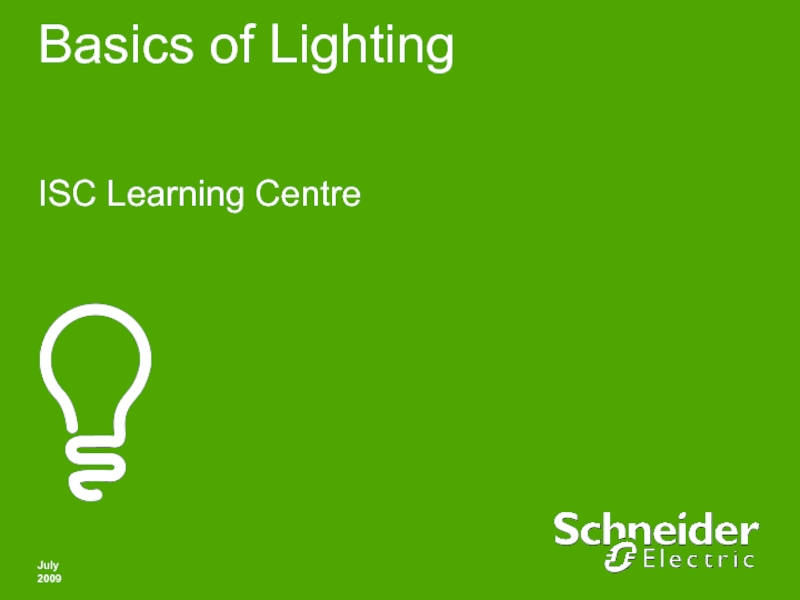
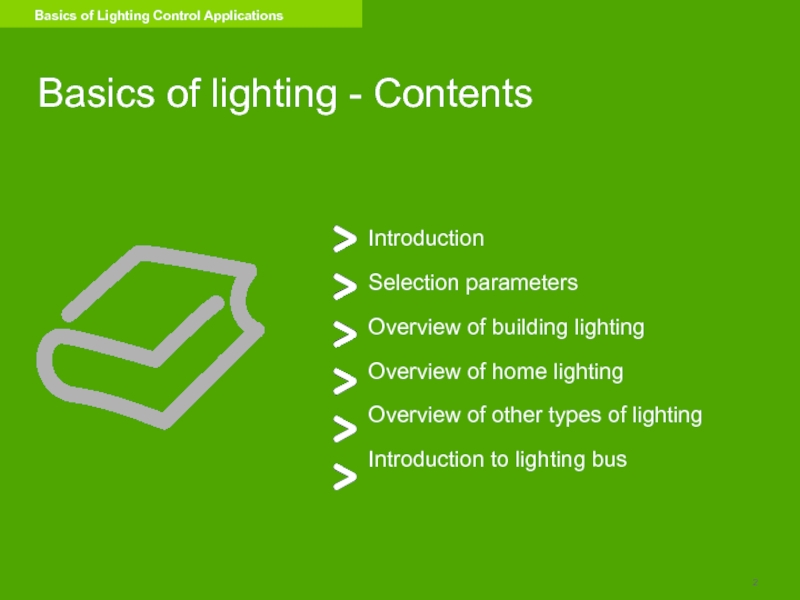
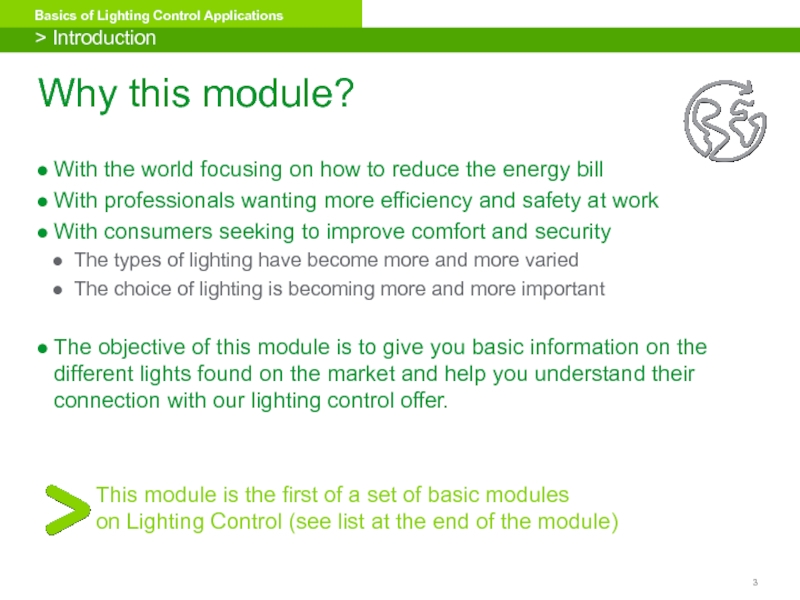
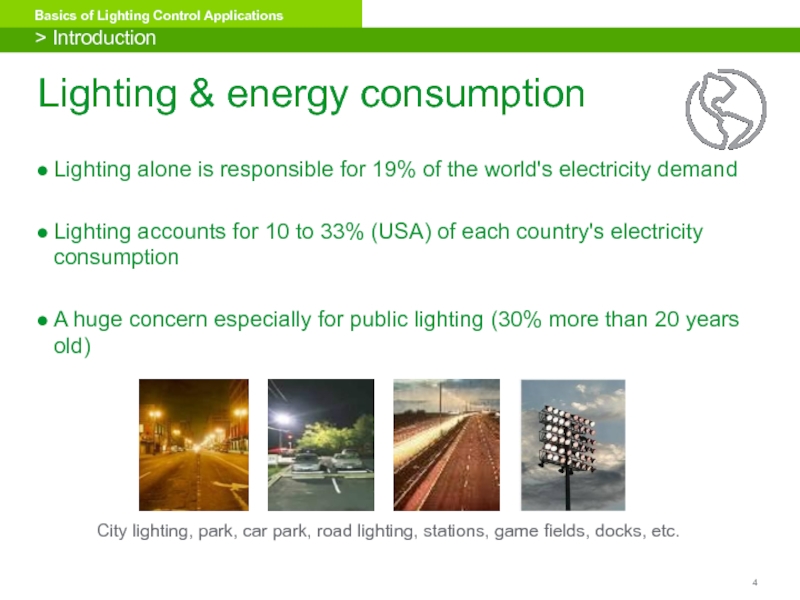
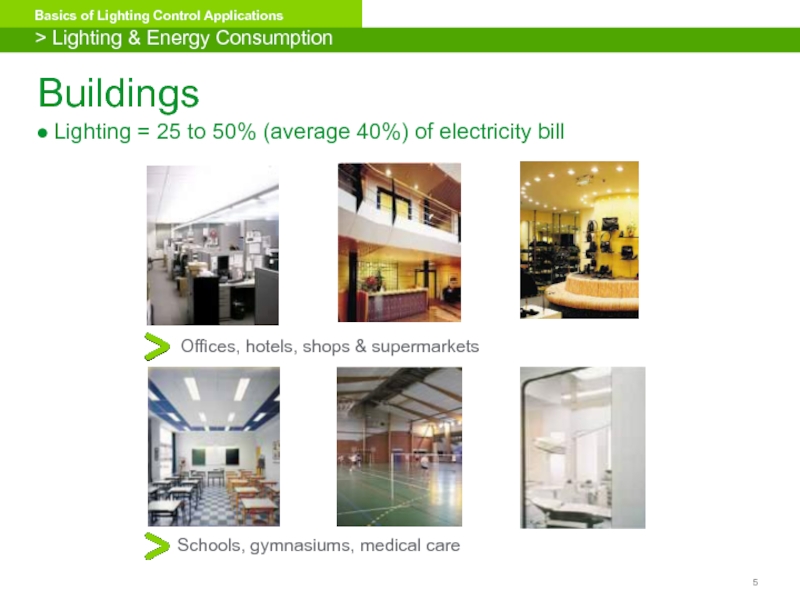
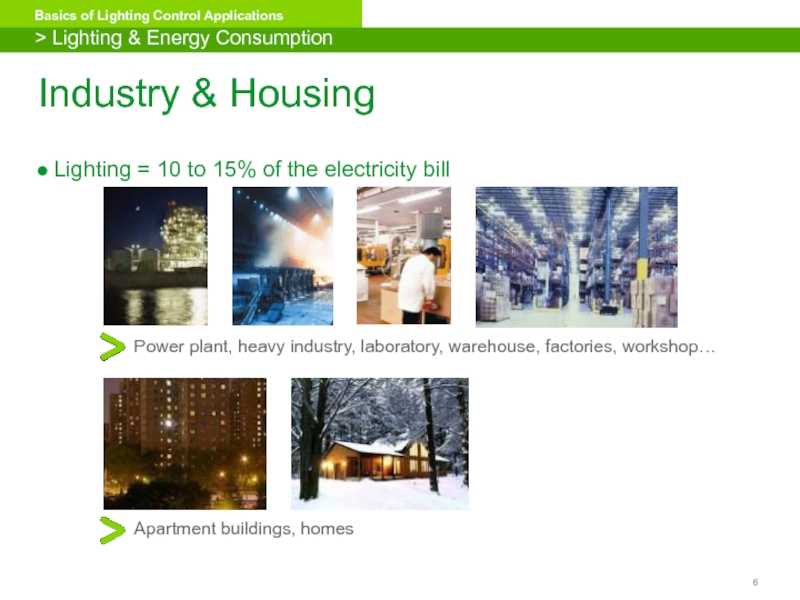

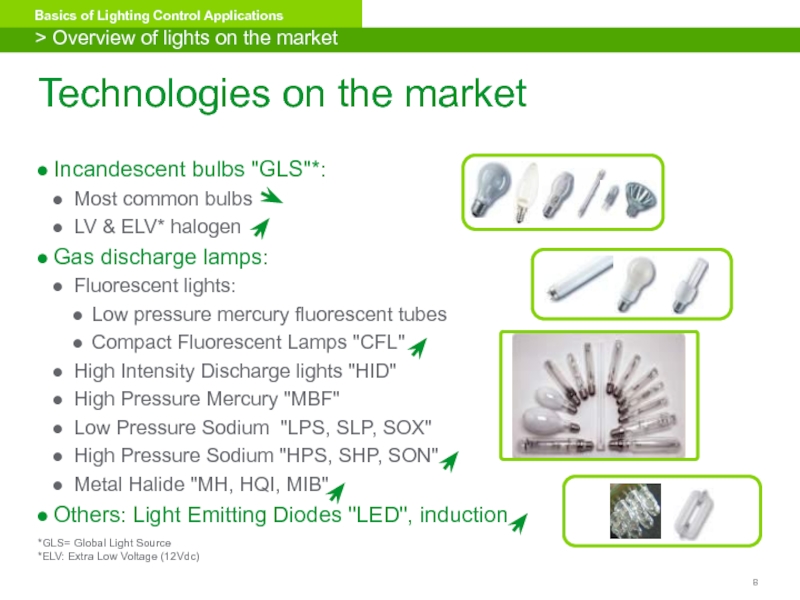
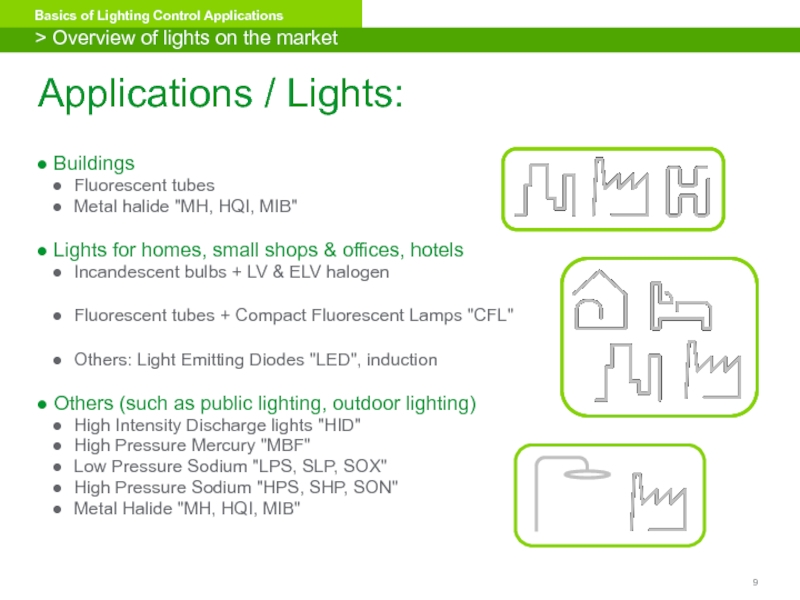
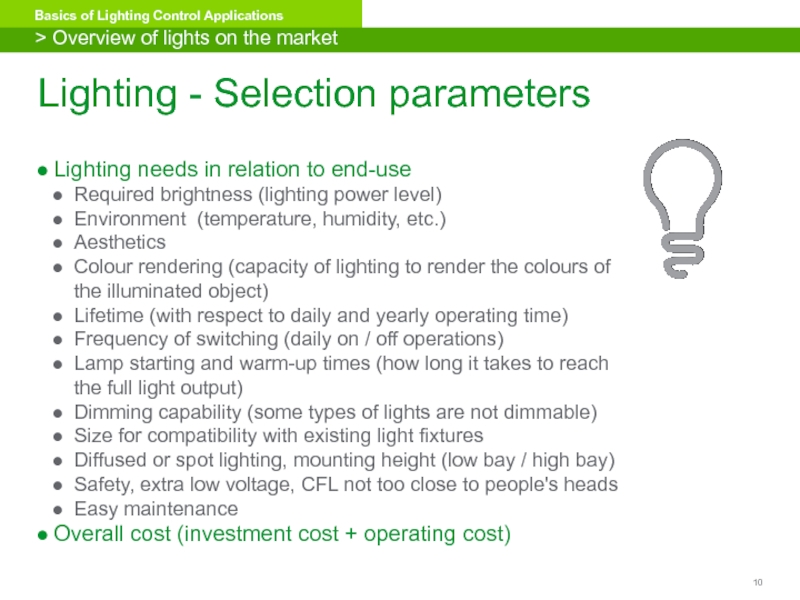
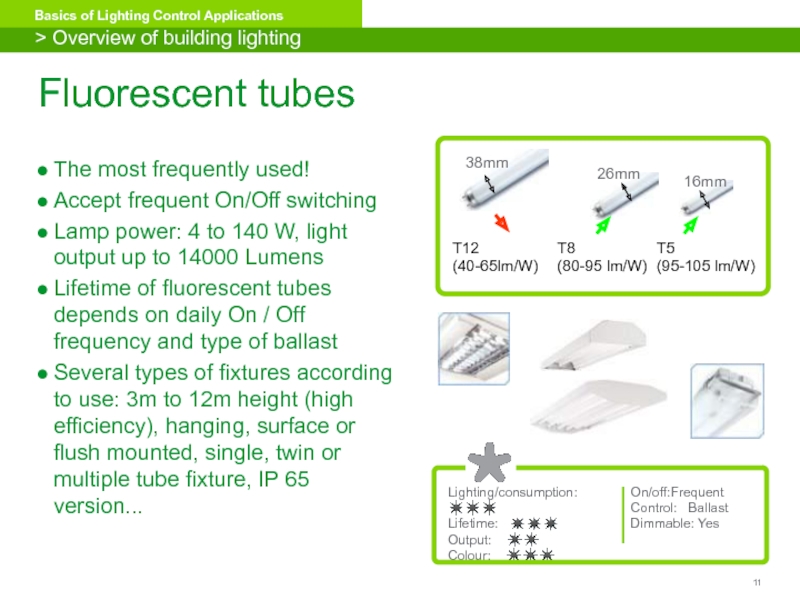
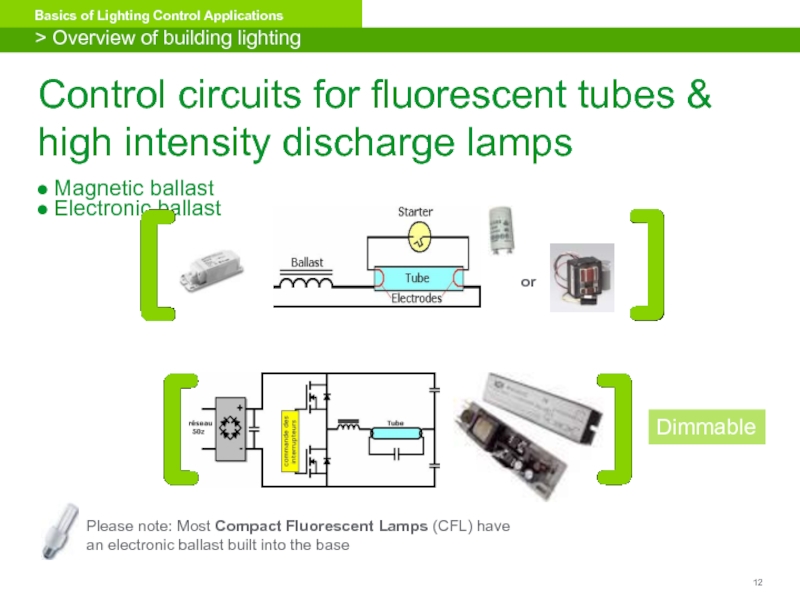
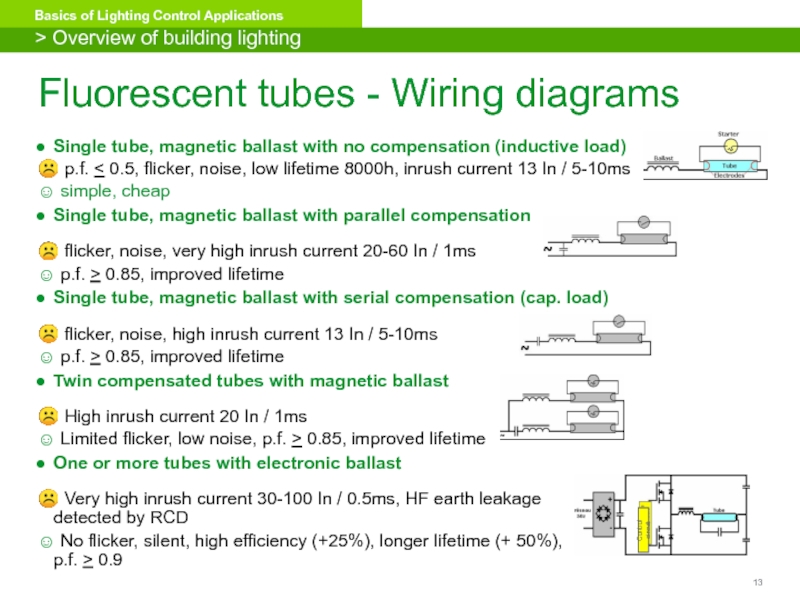
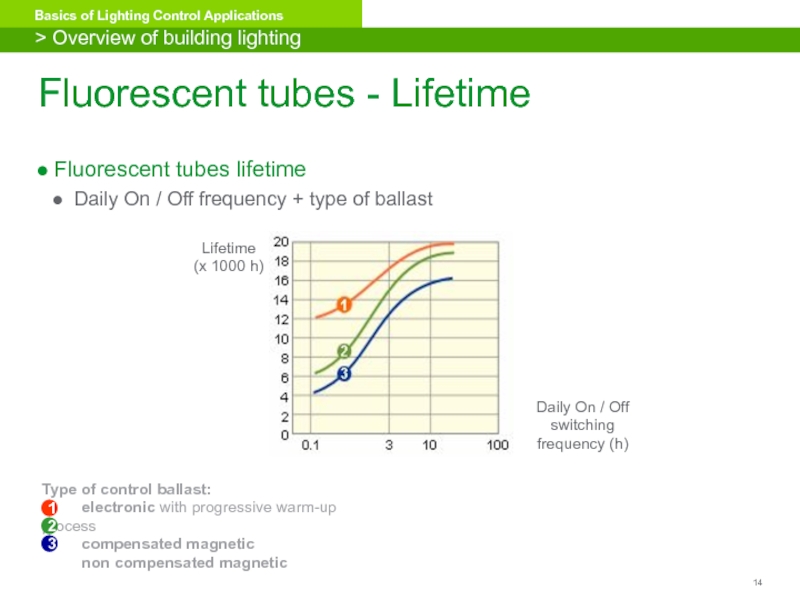


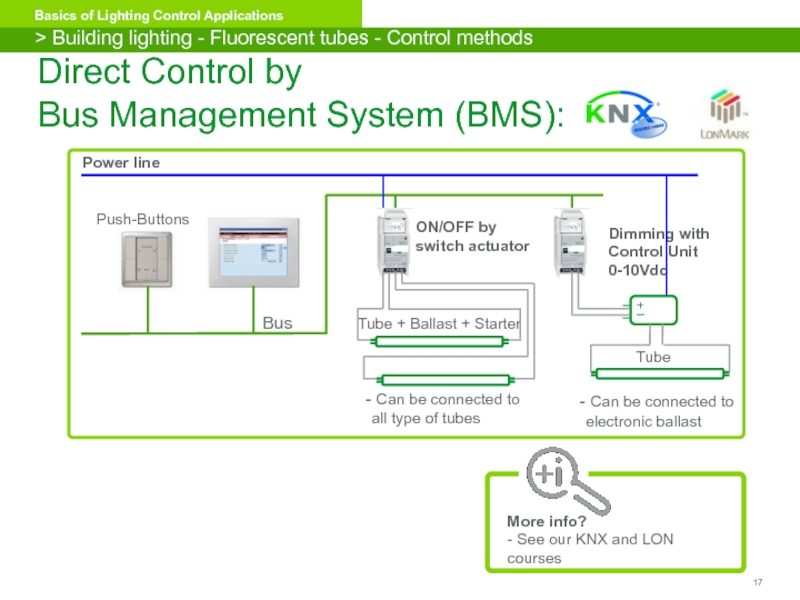
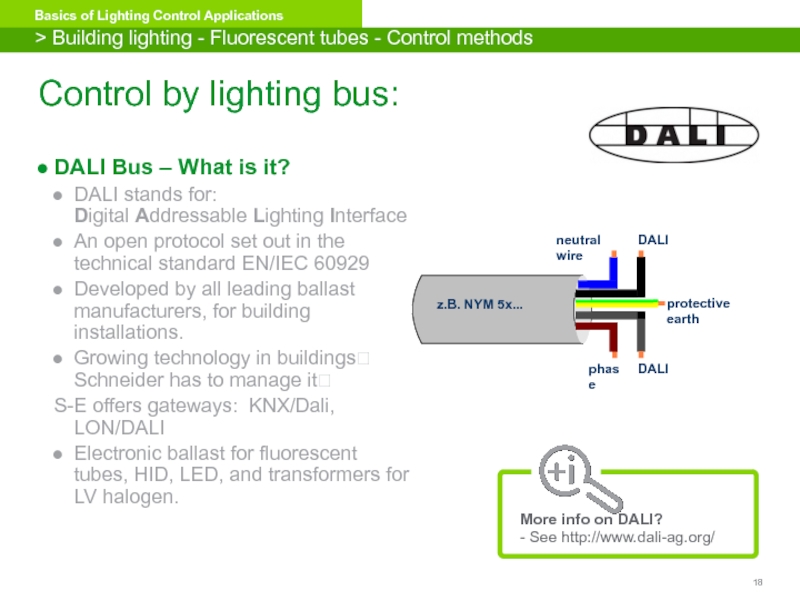
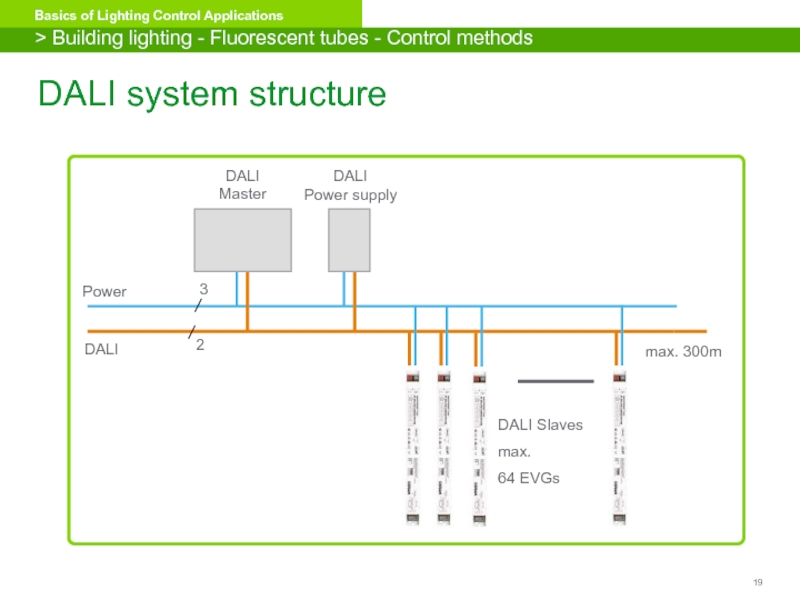
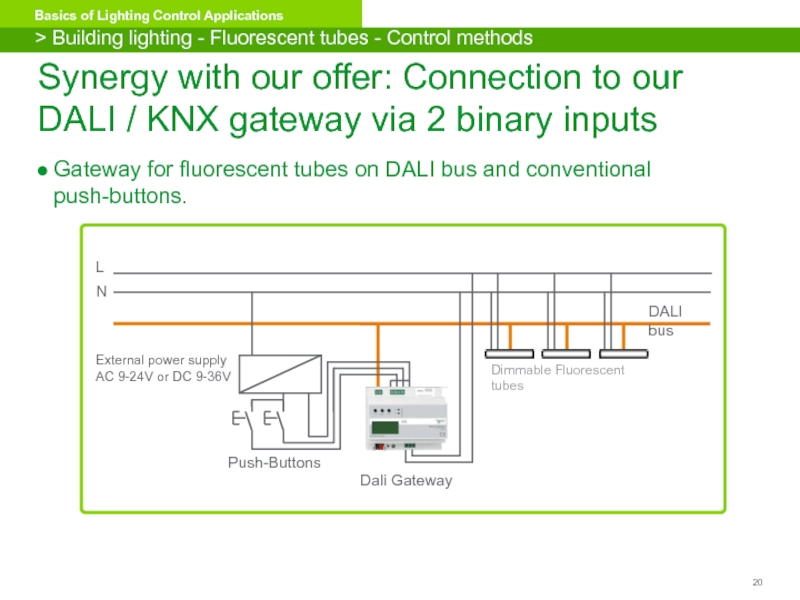
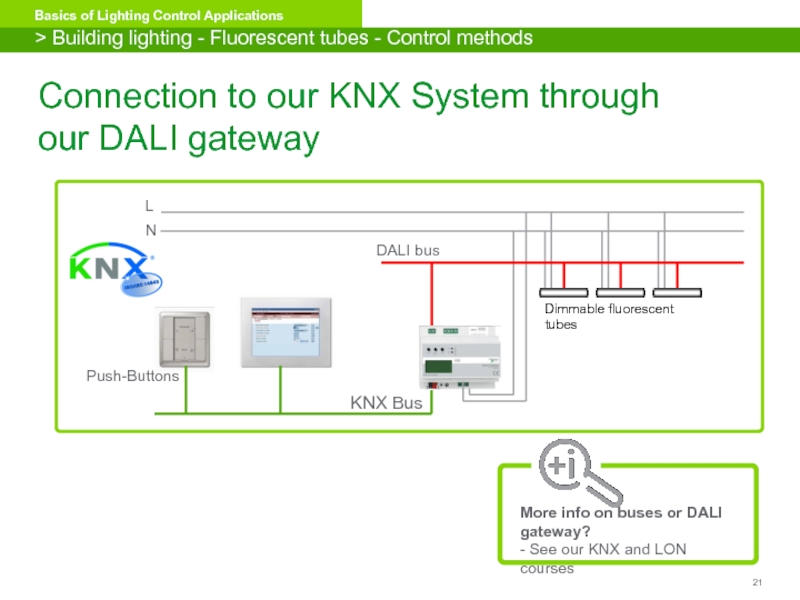
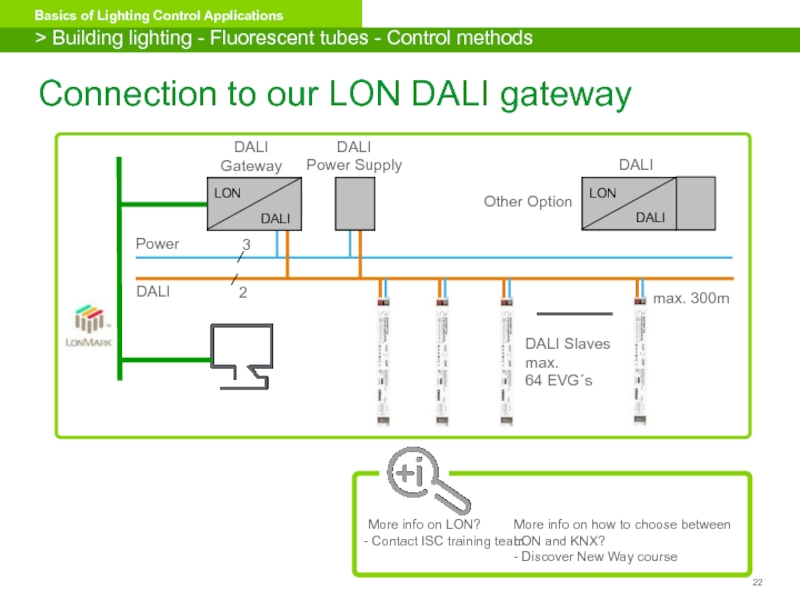
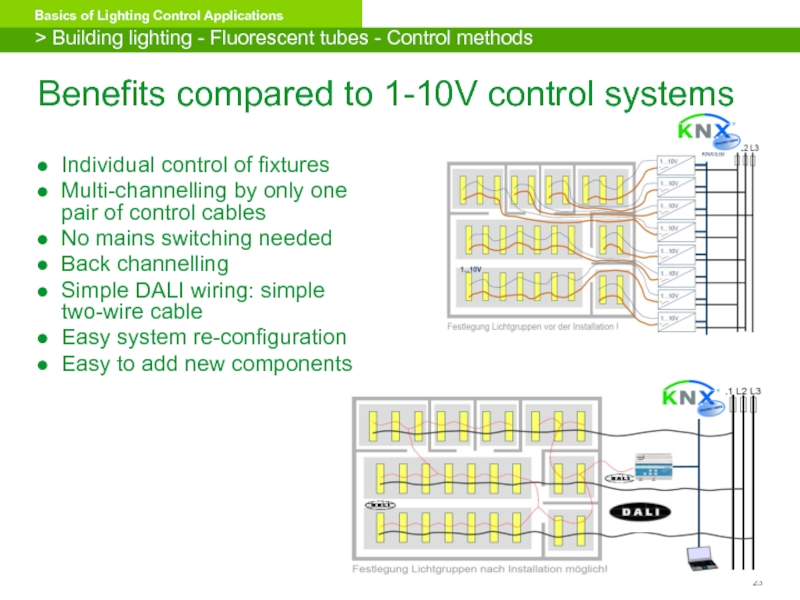
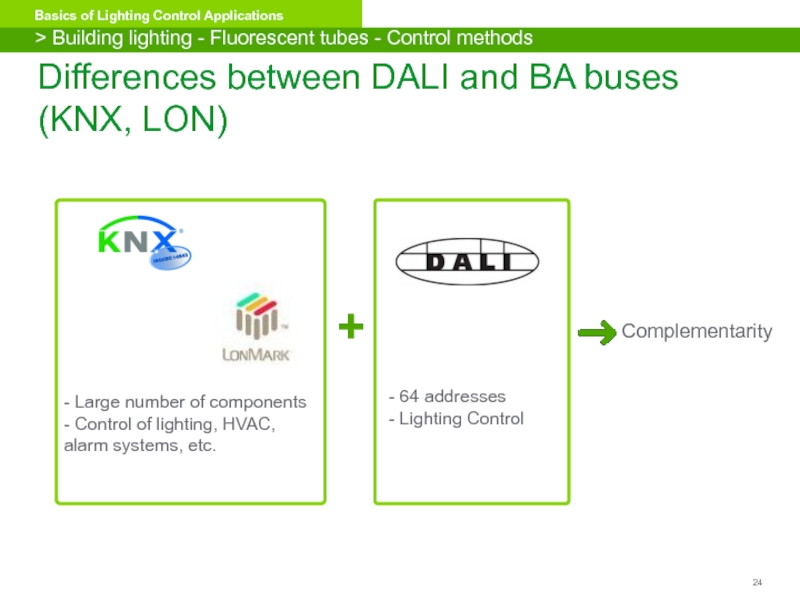
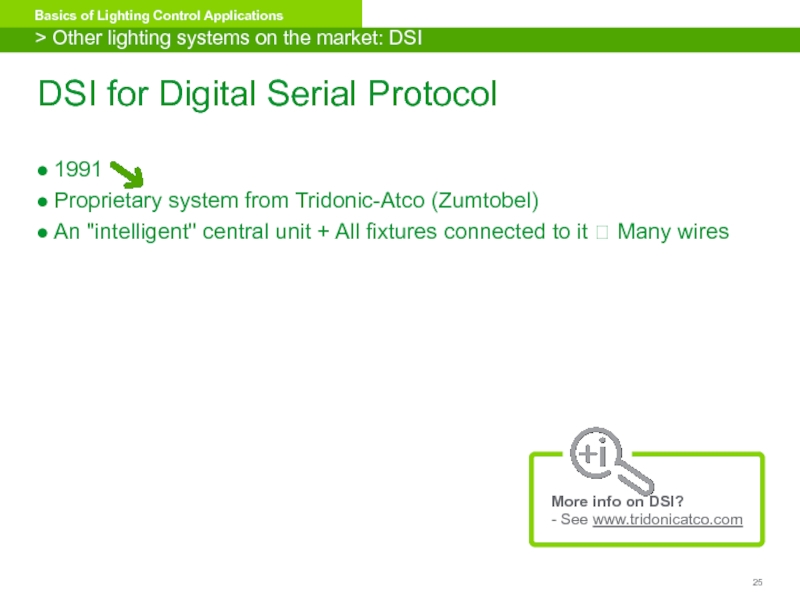
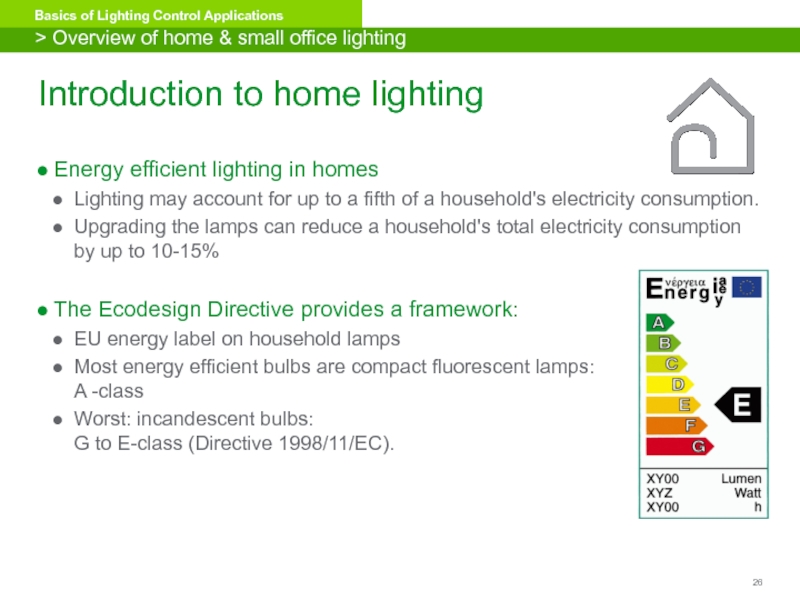
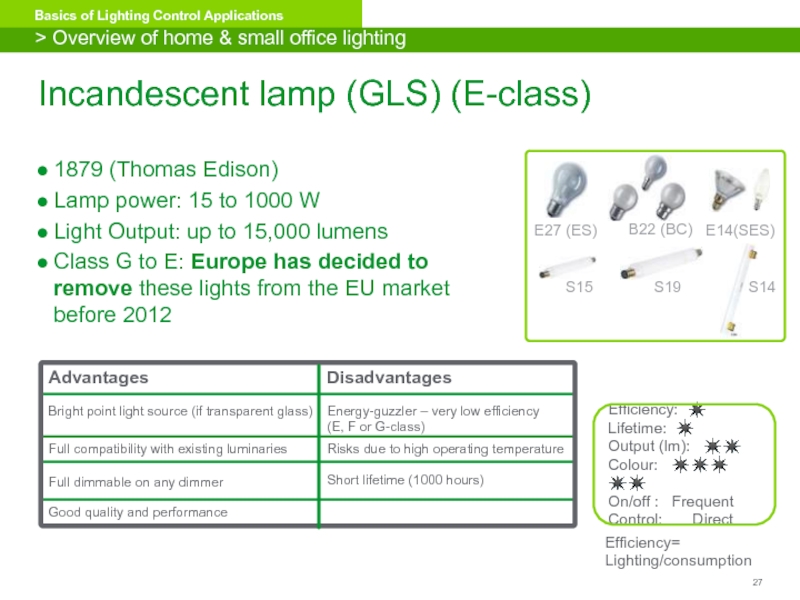
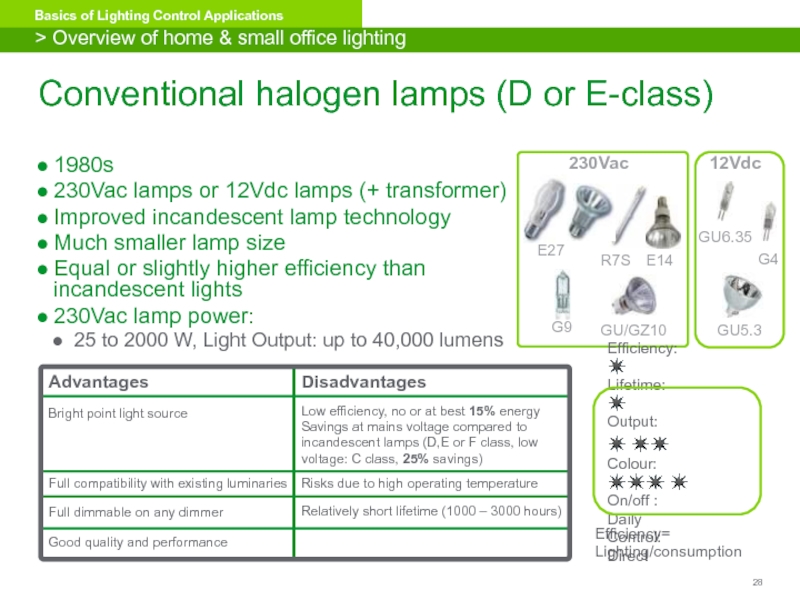
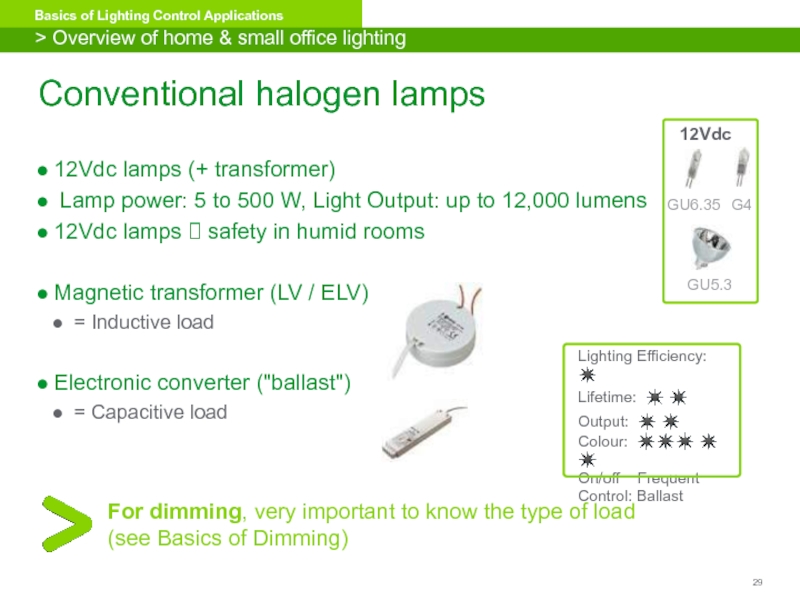
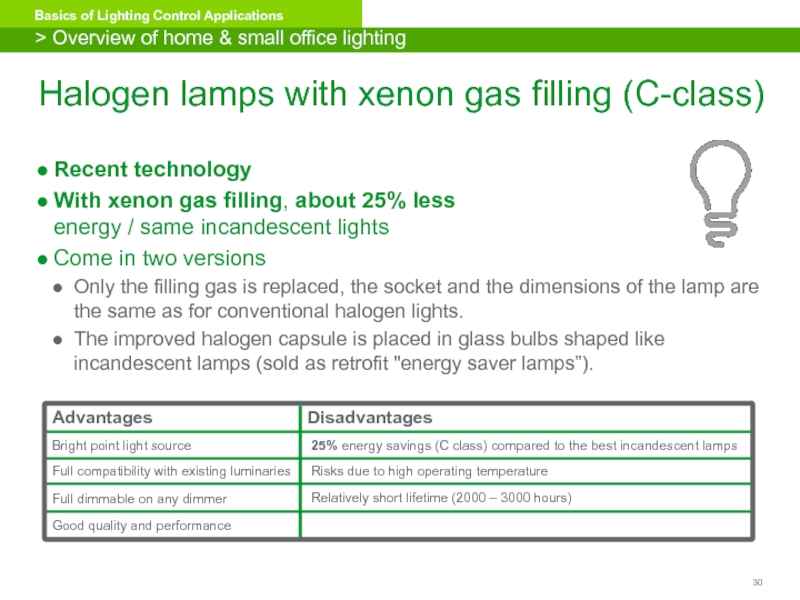
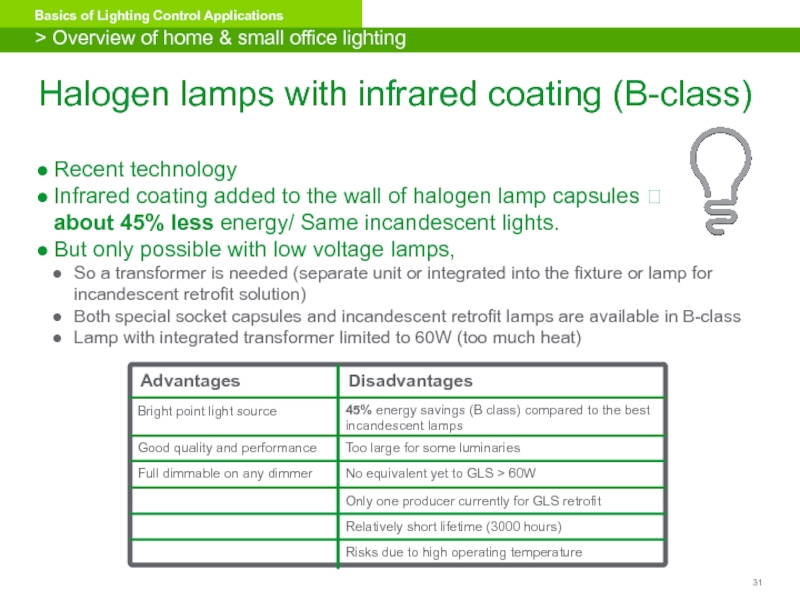
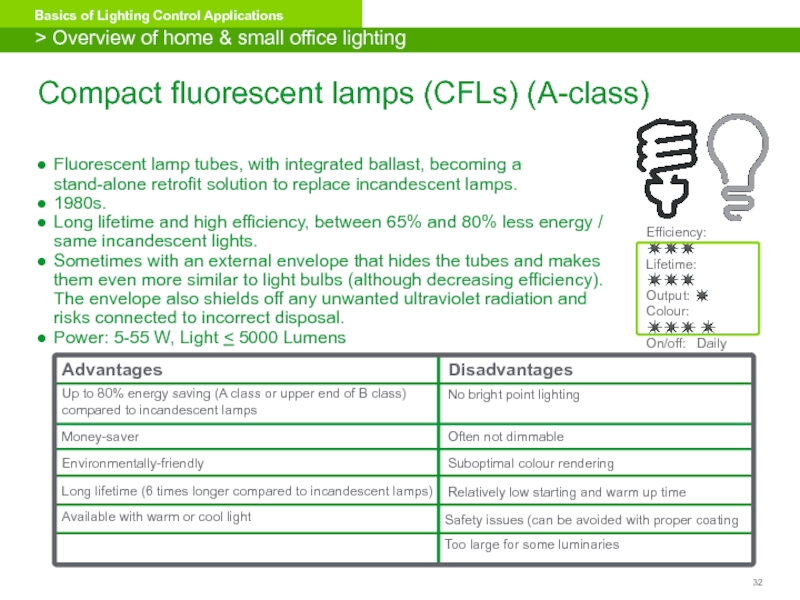

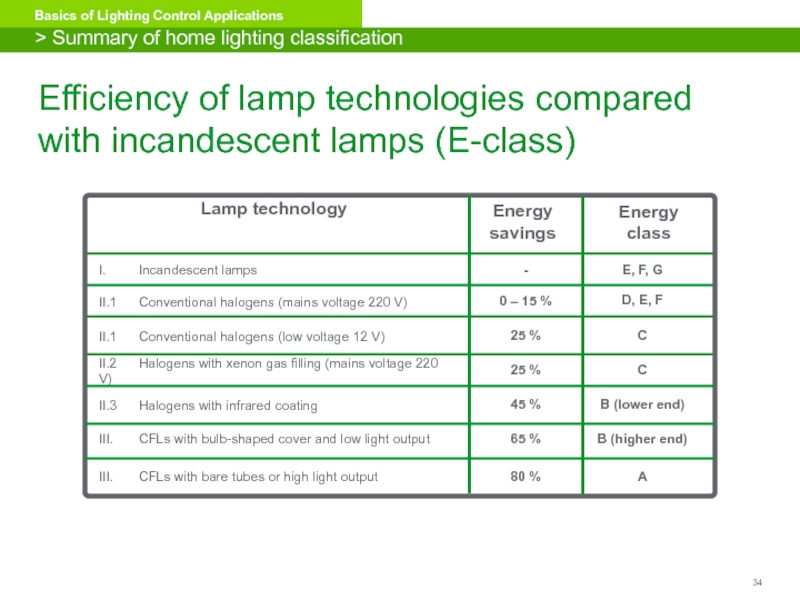
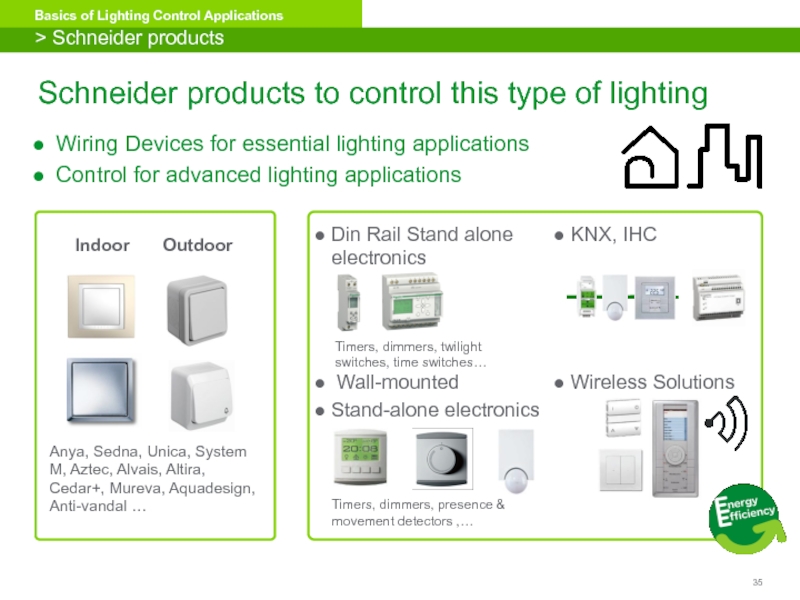
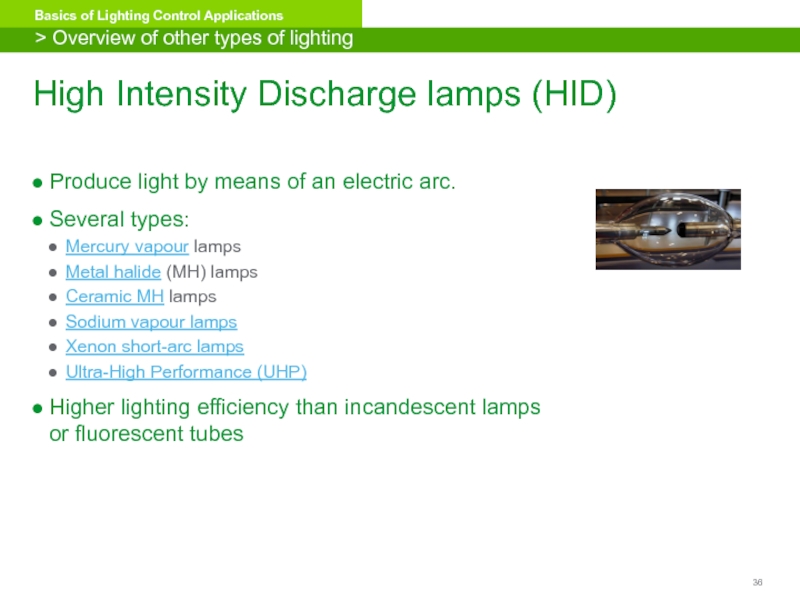
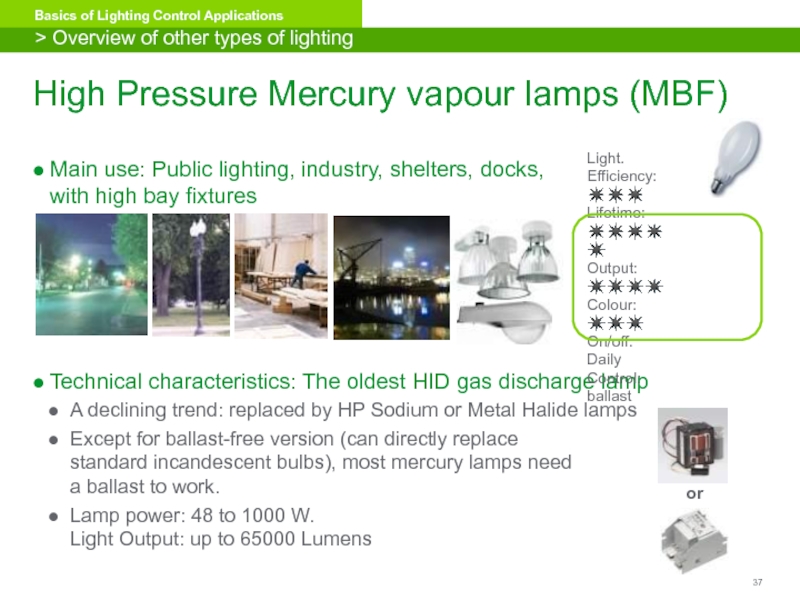
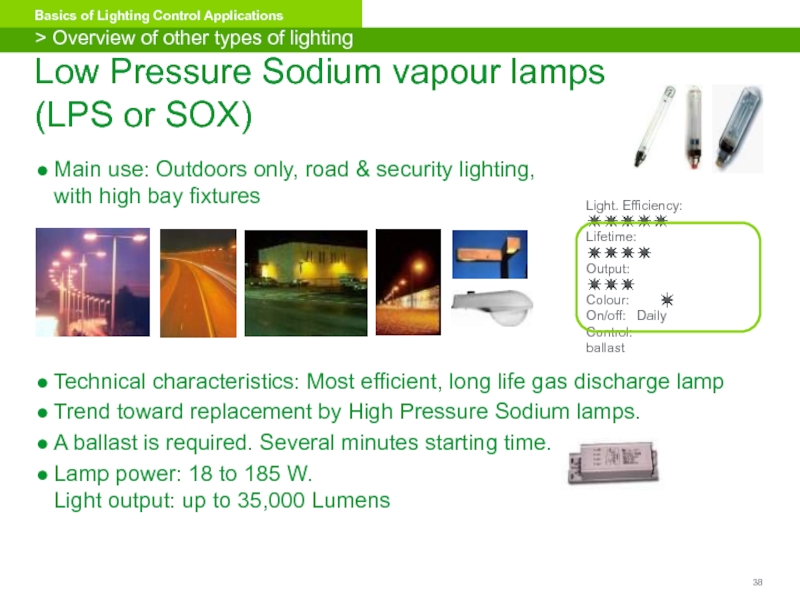
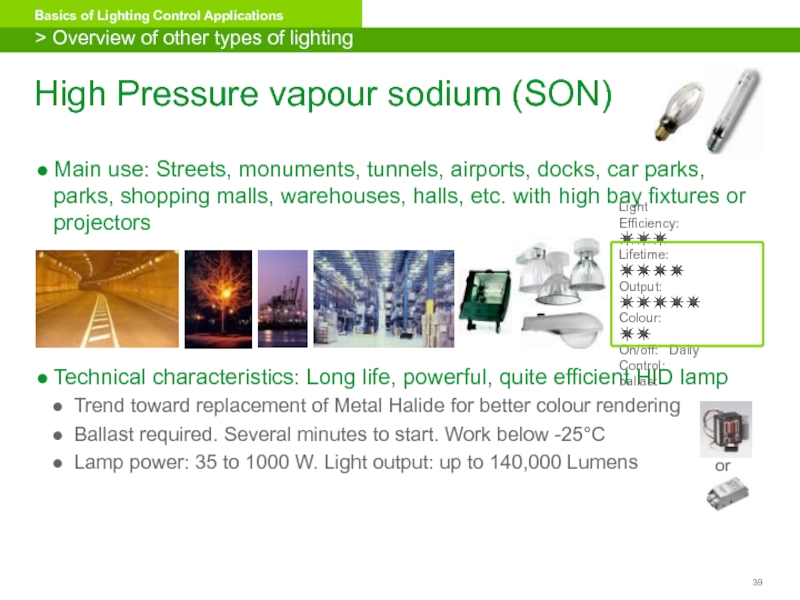
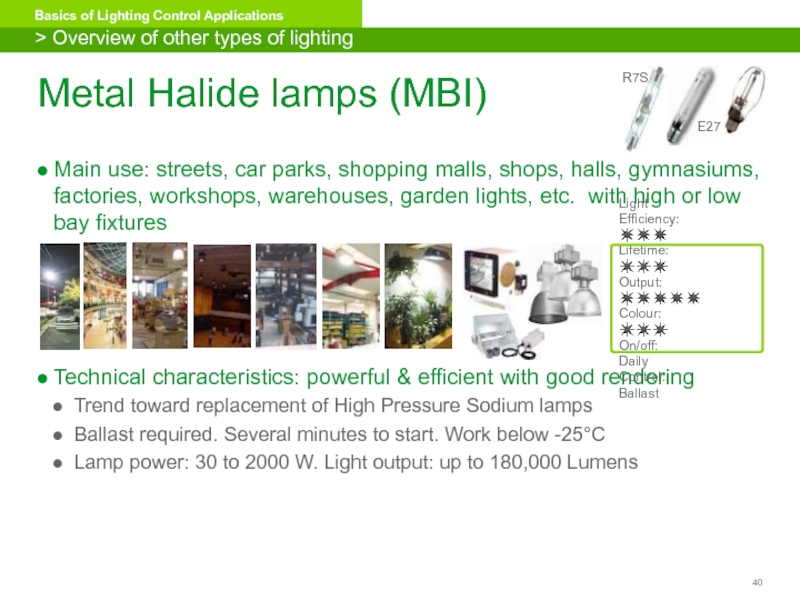

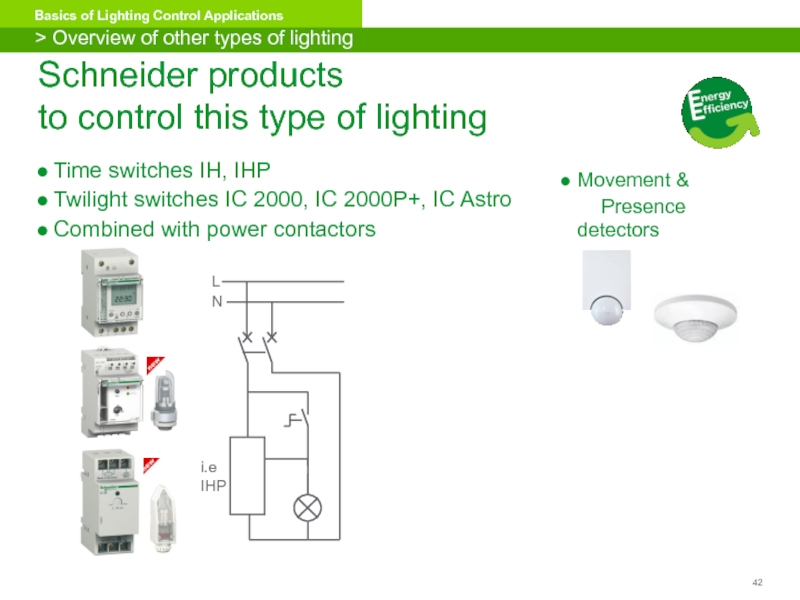
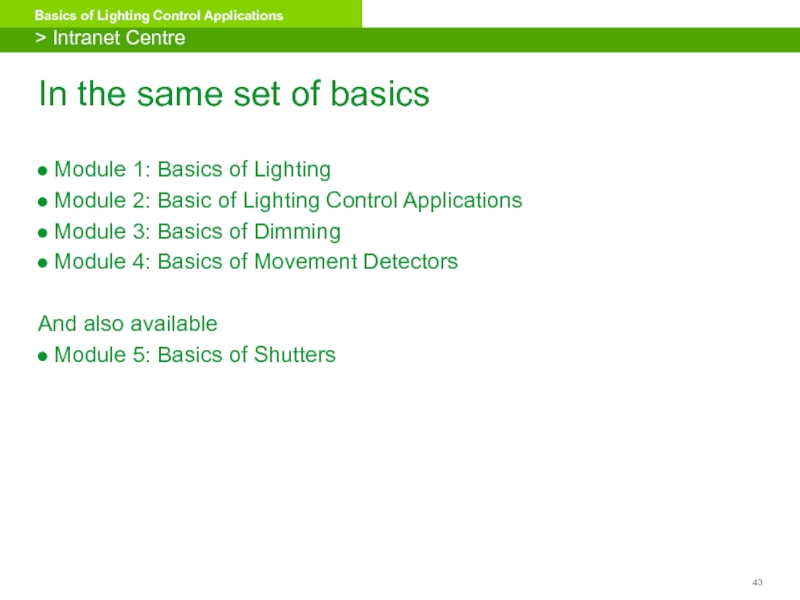
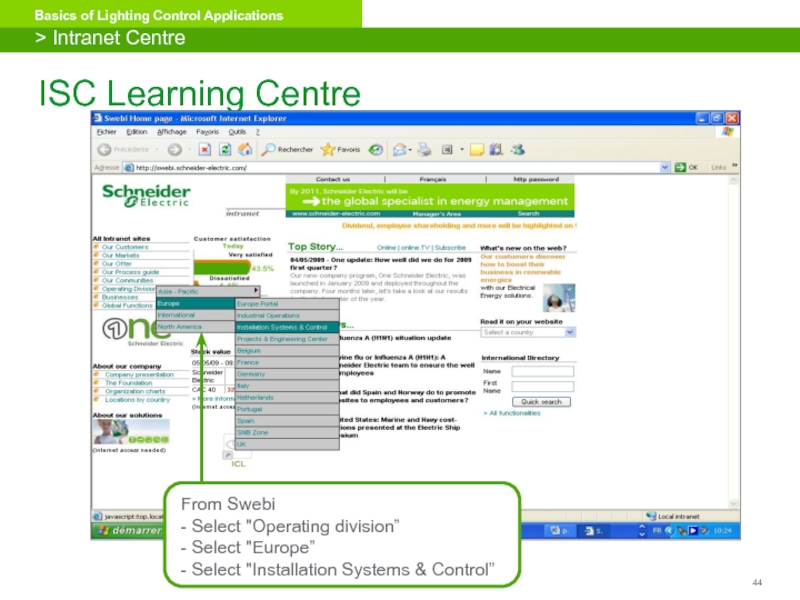 Intranet Centre" alt="">
Intranet Centre" alt="">